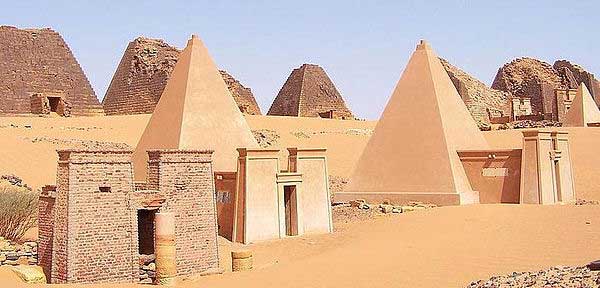
Nubian pyramids are pyramids that were built by the rulers of the Kushite (centered around Napata and Meroe) and Egyptian kingdoms. Prior to the Kushites building these pyramids (which are located in modern day Sudan), there had been no pyramid construction in Egypt and the Nile Valley for more than 500 years.
The area of the Nile valley known as Nubia, which lies within present day Sudan, was home to three Kushite kingdoms during antiquity. The first had its capitol at Kerma from (2600–1520 BC). The second was centered around Napata from (1000–300 BC). Finally, the last kingdom was centered around Meroë (300 BC–AD 300).
Kerma was Nubia's first centralized state with its own indigenous forms of architecture and burial customs. The last two kingdoms, Napata and Meroe, were heavily influenced by ancient Egypt; culturally, economically, politically, and militarily. The Kushite kingdoms in turn competed strongly with Egypt. In fact, during the late period of Ancient Egyptian history, the rulers of Napata conquered and unified Egypt herself. The Napatans ruled as the pharaohs of the Twenty-fifth Dynasty. The Napatan domination of Egypt ended with the Assyrian conquest in 656 BC.
Approximately 220 pyramids were eventually constructed at three sites in Nubia over a period of a few hundred years to serve as tombs for the kings and queens of Napata and Meroë. The first of these was built at the site of el-Kurru, including the tombs of King Kashta and his son Piye (Piankhi), together with Piye's successors Shabaka, Shabataka, and Tanwetamani. Fourteen pyramids were constructed for their queens, several of whom were renowned warrior queens. This can be compared to approximately 120 much larger pyramids that were constructed in Ancient Egypt over a period of 3000 years.
Later Napatan pyramids were sited at Nuri, on the west bank of the Nile in Upper Nubia. This necropolis was the burial place of 21 kings and 52 queens and princes including Anlami and Aspelta. The bodies of these kings were placed in huge granite sarcophagi. Aspelta's weighed 15.5 tons, and its lid weighed four tons. [1] The oldest and largest pyramid at Nuri is that of the Napatan king and Twenty-fifth Dynasty pharaoh Taharqa.